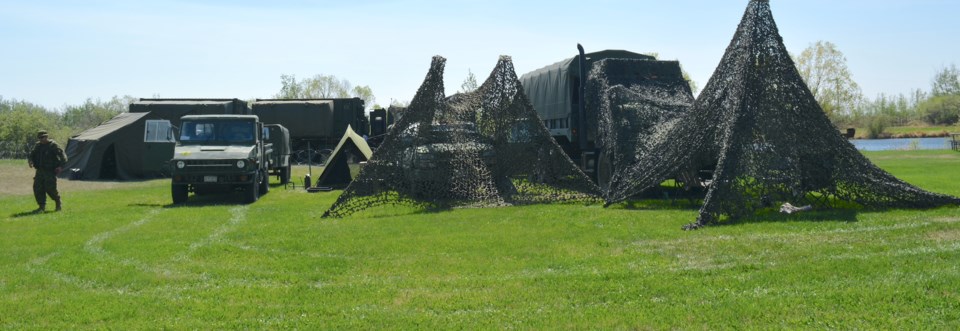WESTLOCK – In the event Canada goes to war or is called upon to assist in one, it’s almost certain that troops will be ready and prepared for battle.
Members with the 1 Canadian Mechanized Brigade Group Headquarters and Signal Squadron, based at Canadian Forces Base (CFB) Edmonton were conducting a training exercise for that very purpose at Rainbow Park east of Westlock, May 13-14.
About 70 soldiers in two units took part in the week-long training exercise across parts of Westlock and Athabasca Counties between May 10-19, and conducted communications training with specialized equipment regularly used for military operations.
“We are practising the tactical movement of the brigade command post so that we can be prepared to move it in a real scenario quickly and effectively if necessary,” said squadron commander Capt. Jon Barraclough. “We provide both voice communications over radio as well as data communications over satellite.”
Barraclough said the training held each spring is the unit’s big exercise for the year and is an exercise they use to refine and sharpen their skills. “This is our opportunity to ensure that we are ready in case Canada needs us and that we have the skills required to be able to do our jobs in the event of a domestic emergency like the wildfires going on or something international like the conflict in Eastern Europe,” he said. “We just need to be ready to go and serve Canada … and the only way to do that is by practising and that’s why we’re out here doing this.”
Three command posts were set up in Westlock County with one at Rainbow Park, one in the Hamlet of Jarvie and another located on a Crown land east of the Village of Clyde. Each comprised of about 15 soldiers, while two radio rebroadcasting detachments with three personnel and the remainder 20 to 30 people located at Camp Wright near Colinton in Athabasca County, where the base camp was located and had “vehicles moving in between those different sites doing things like resupply and repairs,” said Barraclough.
During the training exercise they used radio rebroadcasters over a 50-kilometre distance and a rear-link satellite communication dish back at CFB Edmonton, to talk with soldiers and back up data networks to their different locations.
“So at any one time right now out in this area we’ve got two command posts going and we’ve got two radio rebroadcasters going and both command posts are doing the same thing,” he said. “We practice using both so we can have a quick transition between the two when it needs to happen for the brigade staff to control the battle.”
In addition to generators, satellites, and servers, other equipment on site for training included a vehicle known as a Medium Support Vehicle System Load Handling System (MSVSLHS). “It’s a large truck that has a crane on the back that can pick up and move different pieces of equipment onto the bed of the truck,” explained Barraclough, noting the one located in Rainbow Park had a mobile office — a working area with tables, computers, radios and other equipment. “It becomes the working area for that brigade command post.” Another type of vehicle was the Light Support Vehicle Wheeled (LSVW). “Those vehicles are operated by signal operators who set up the communications equipment inside (with the giant antennas) and that’s what’s providing our voice communication over the radio,” he said. “We have line technicians that run lines into our command post and then we can operate the radio from inside the LHS.”
Training for the unit is usually conducted near CFB Wainwright, noted Barraclough, adding the unit is very specialized in terms of what they do and is not the typical army unit. “My unit’s made up of technical people. We are signallers, we are maintainers, we are logistics personnel who serve the purpose of, instead of fighting the battle, supporting the battle,” said Barraclough. “That’s why we need to practice the movements and the sustainment part of that operation and most importantly for my unit specifically, the command support in terms of the communications requirements between the commanders and their moving unit.”



